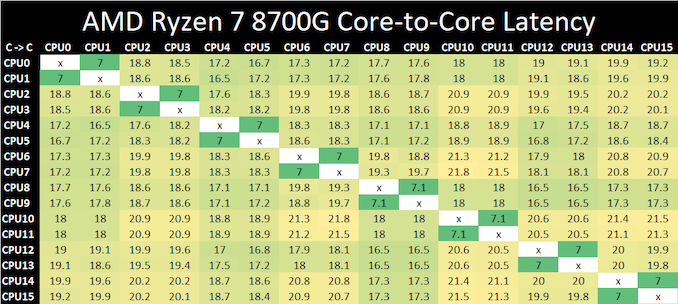AMD Ryzen 7 8700G and Ryzen 5 8600G Review: Zen 4 APUs with RDNA3 Graphics
by Gavin Bonshor on January 29, 2024 9:00 AM EST- Posted in
- CPUs
- AMD
- APUs
- Phoenix
- 4nm
- Zen 4
- RDNA3
- AM5
- Ryzen 8000G
- Ryzen 7 8700G
- Ryzen 5 8600G
Core-to-Core Latency
As the core count of modern CPUs is growing, we are reaching a time when the time to access each core from a different core is no longer a constant. Even before the advent of heterogeneous SoC designs, processors built on large rings or meshes can have different latencies to access the nearest core compared to the furthest core. This rings true especially in multi-socket server environments.
But modern CPUs, even desktop and consumer CPUs, can have variable access latency to get to another core. For example, in the first generation Threadripper CPUs, we had four chips on the package, each with 8 threads, and each with a different core-to-core latency depending on if it was on-die or off-die. This gets more complex with products like Lakefield, which has two different communication buses depending on which core is talking to which.
If you are a regular reader of AnandTech’s CPU reviews, you will recognize our Core-to-Core latency test. It’s a great way to show exactly how groups of cores are laid out on the silicon. This is a custom in-house test, and we know there are competing tests out there, but we feel ours is the most accurate to how quick an access between two cores can happen.
Looking at core-to-core latencies of the AMD Ryzen 7 8700G, as this is a monolithic Phoenix die, we can see good inter-core latencies between each of the eight individual Zen 4 cores. Going within the core, we can see solid latencies of 7ns, while things inter-core range between 17 and 21ns, showing that the Ryzen 7 8700G uses a single core cluster of eight cores.
Similar to what we've seen on previous iterations of Zen 4 and Zen 3, albeit on processors with multiple core complex (CCXs) such as the Ryzen 9 7950 and Ryzen 9 5950X, inter-core latencies are strong and low. In contrast, the Ryzen 7 8700G and other Ryzen 8000G monolithic chips on a single die remove the complications and penalties of connecting through AMD's Infinity Fabric interconnect. The Ryzen 7 8700G uses TSMC's refined 4nm manufacturing process, exactly the same as the Ryzen 7040 mobile, which is coincidentally the exact same design as the 8700G, given that AMD has repurposed Phoenix for use on AMD's AM5 desktop platform.
The core-to-core latency performance is inherently strong on the Ryzen 7 8700G, with low inter-core latencies. As expected, latency degrades a little going across the entire complex, but certainly not within the range where we would expect these penalties to cause latency issues when cores have to communicate with each other.











111 Comments
View All Comments
Violet Giraffe - Monday, March 11, 2024 - link
The article doesn't list iGPU specs?